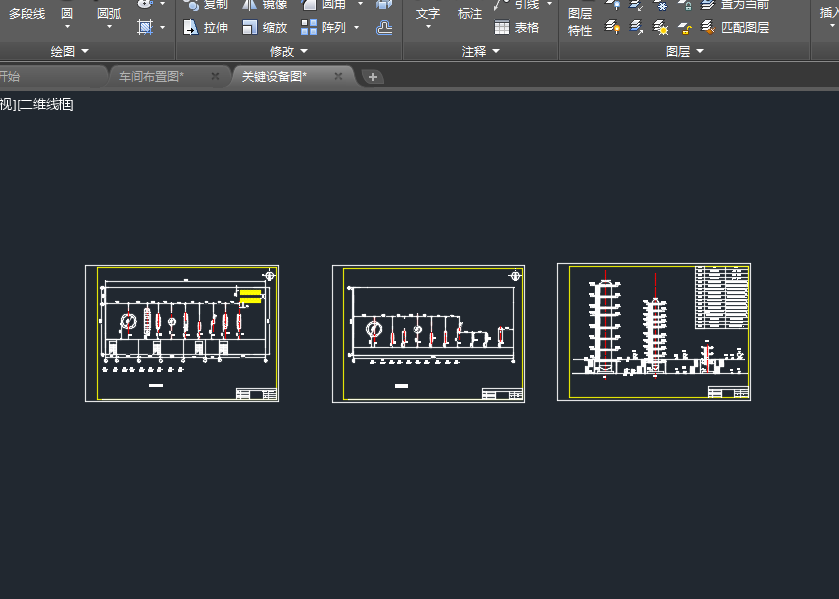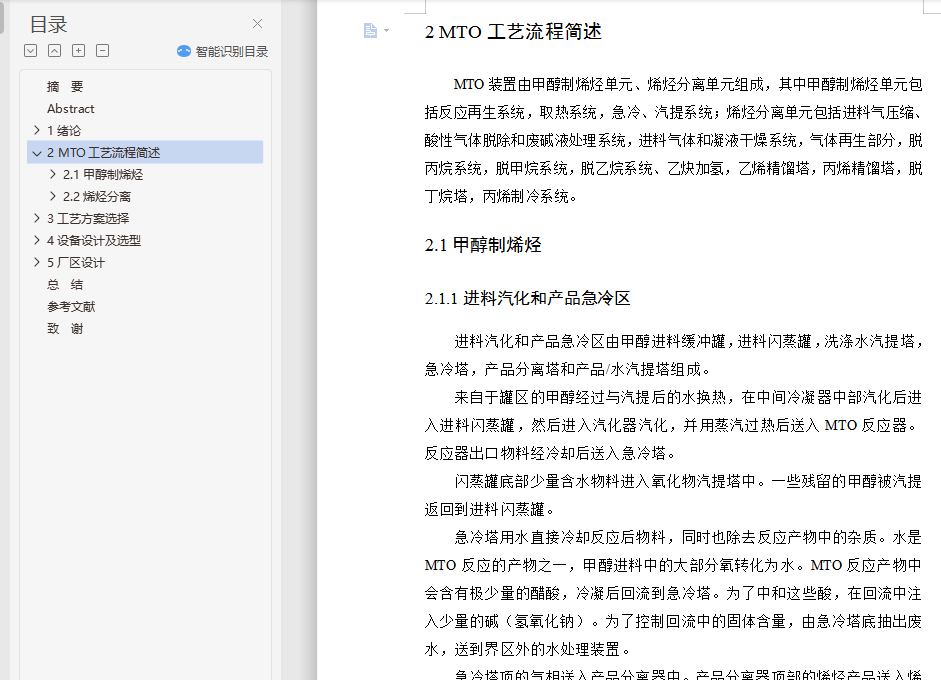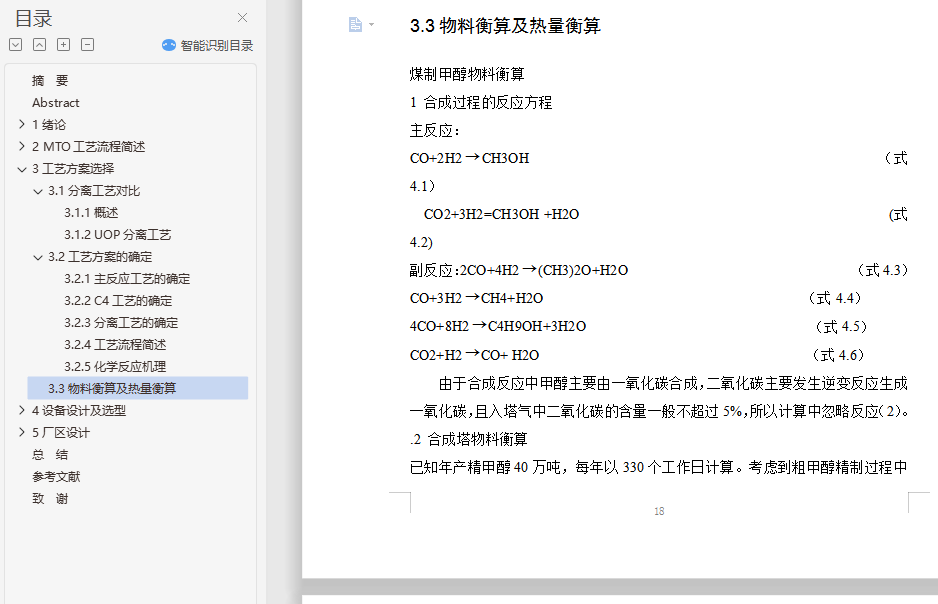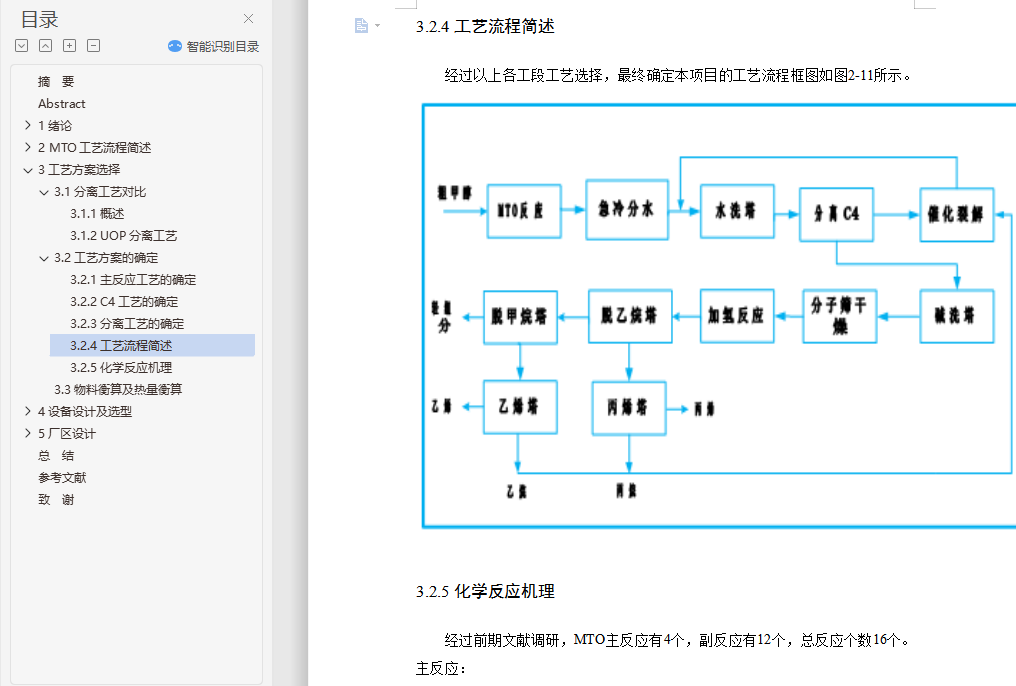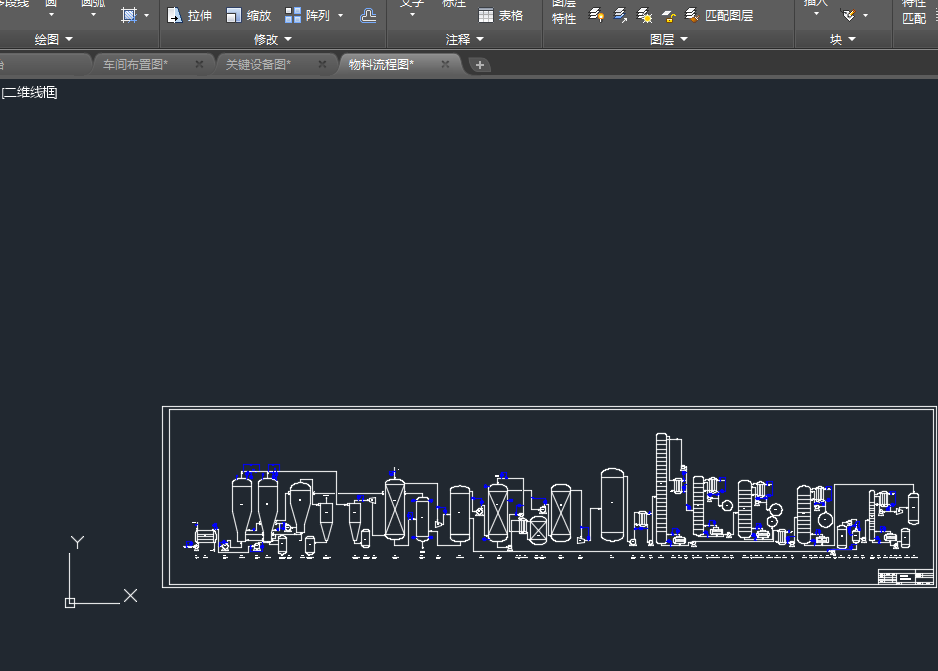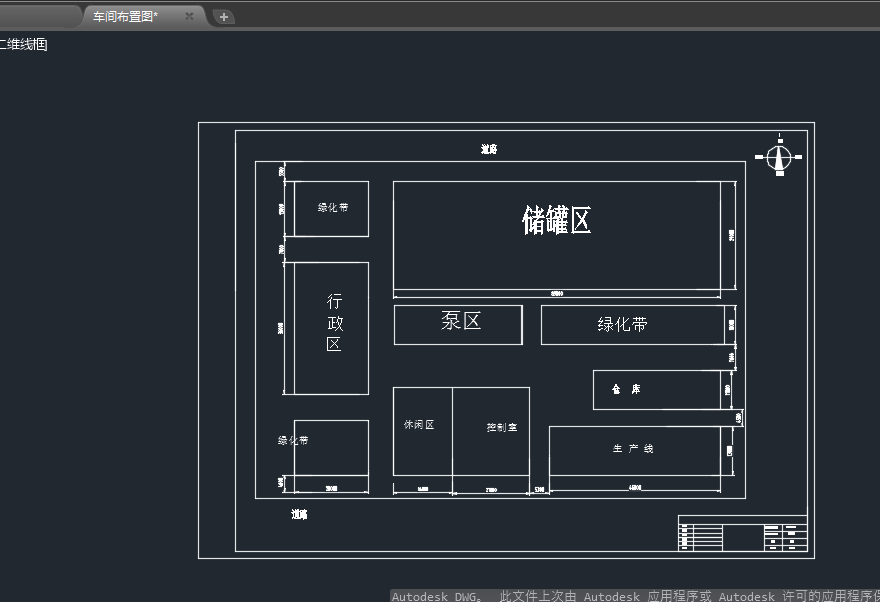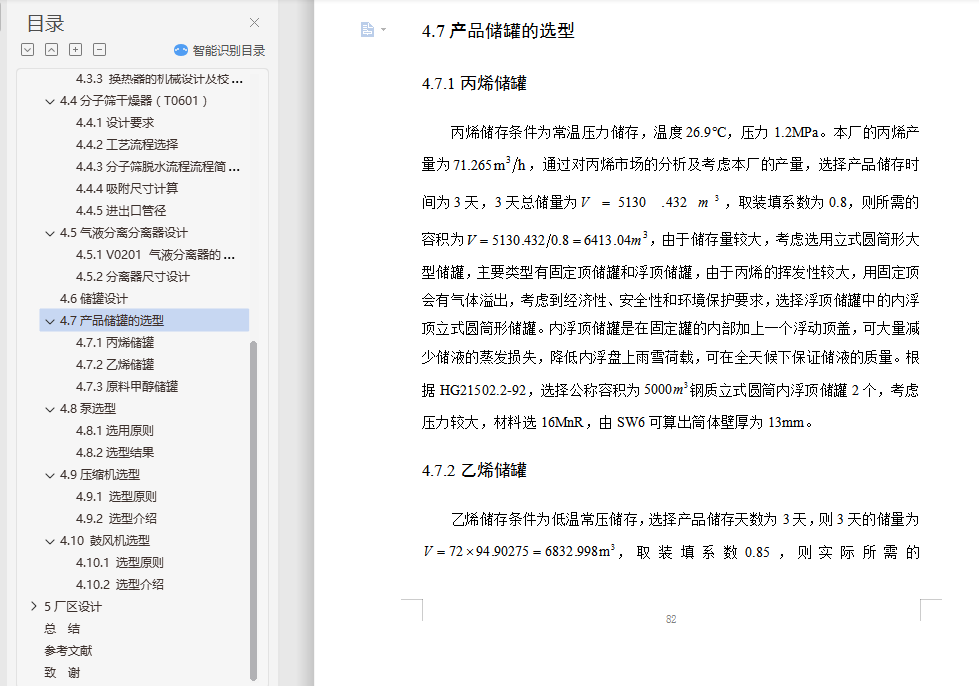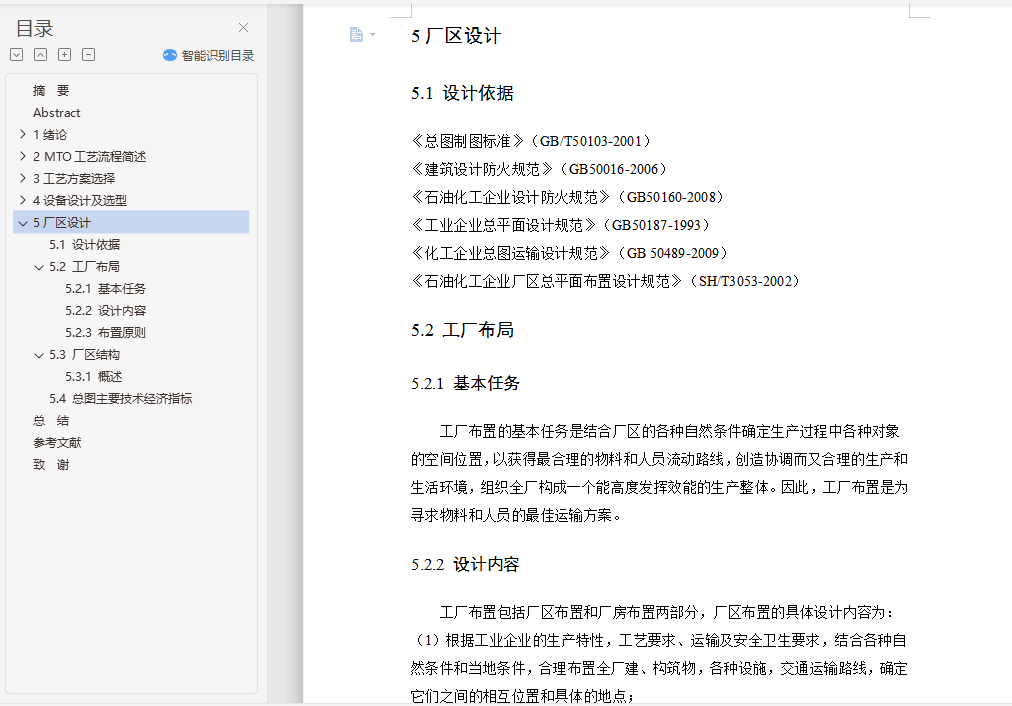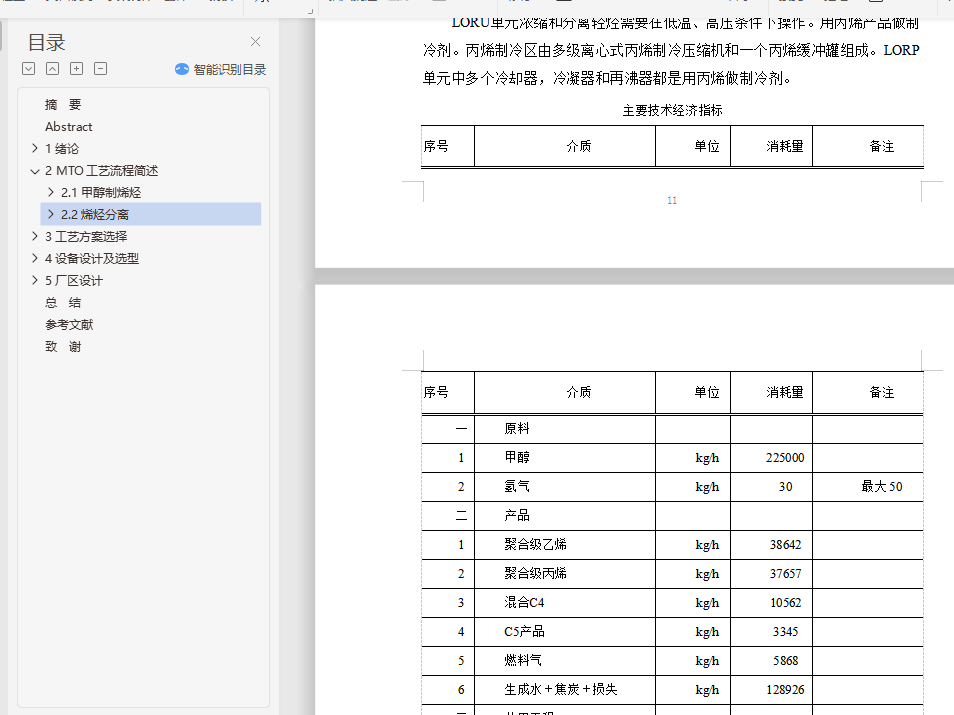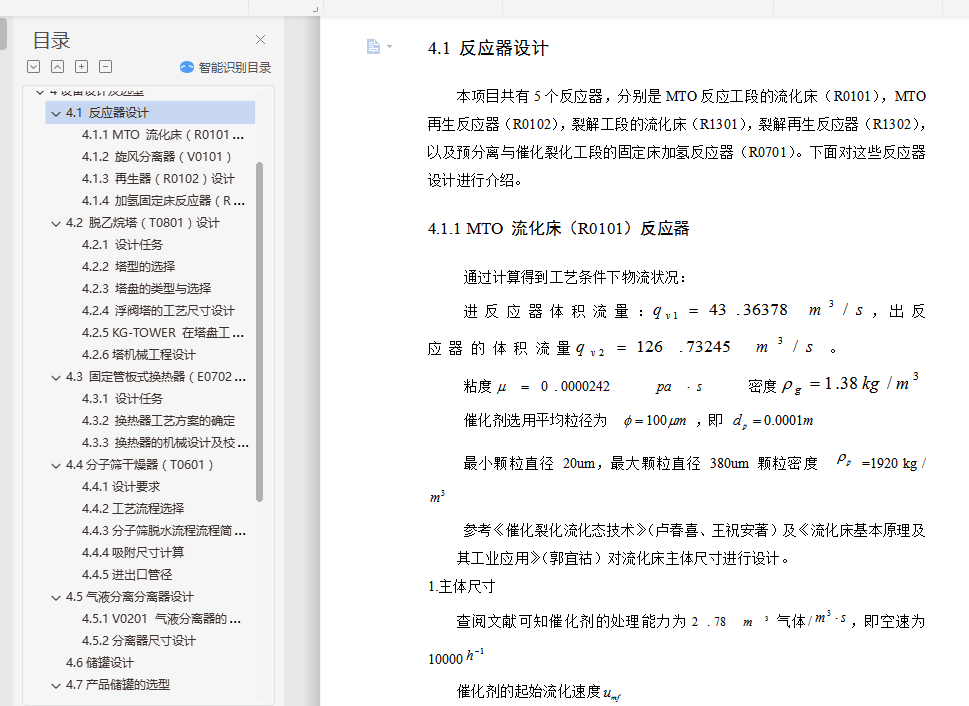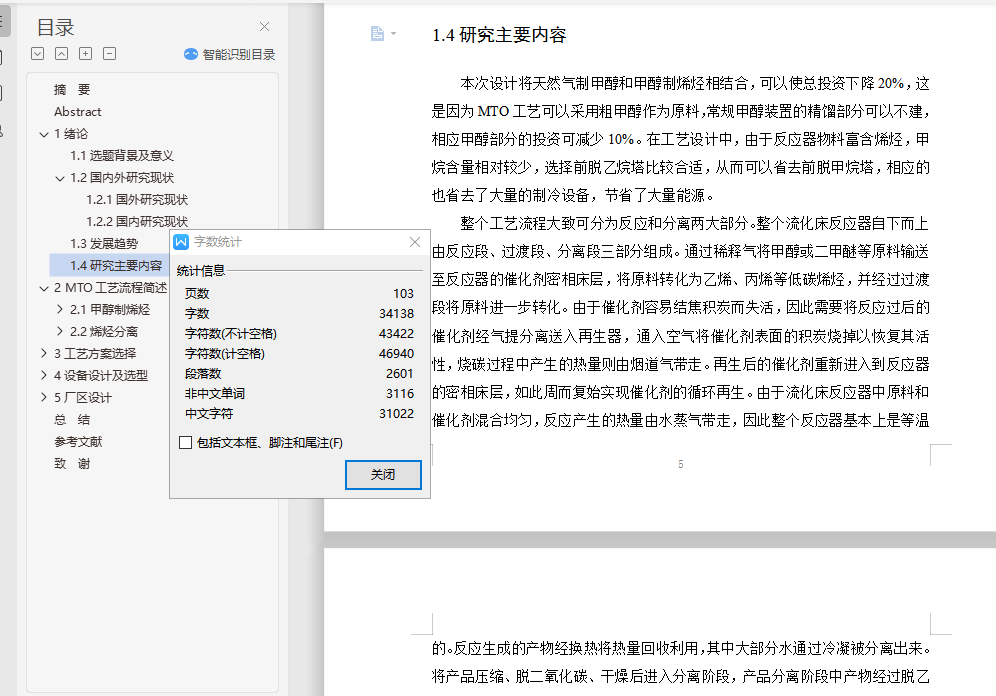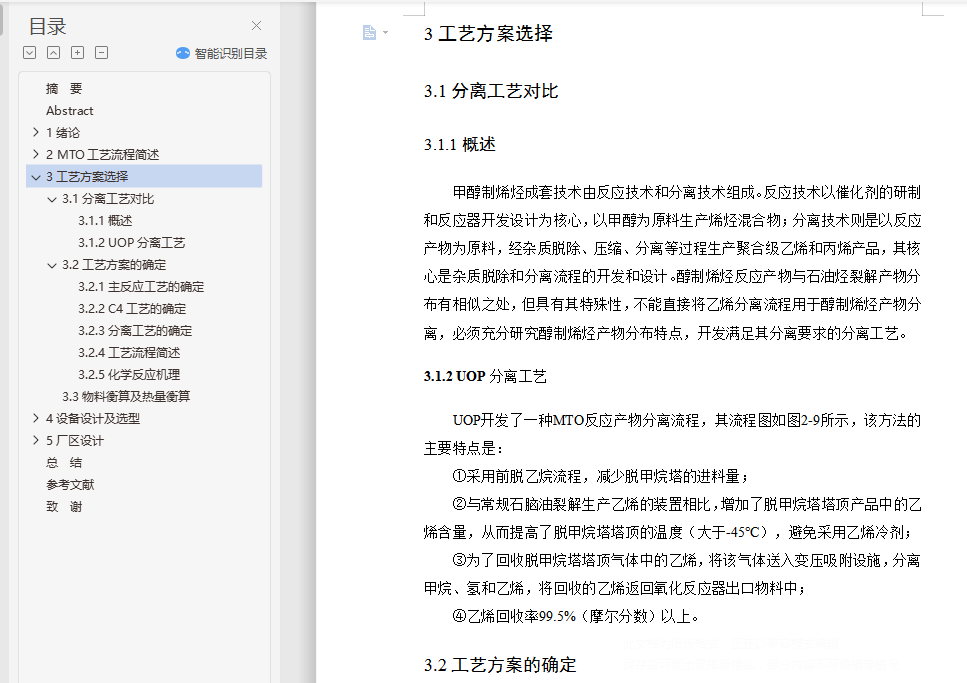摘 要
甲醇经换热汽化后与补充的新鲜催化剂、循环再生催化剂一起进入流化床反应器底部,在该反应器内甲醇接近100%地被转化,生成低碳烯烃及其他副产物,反应产物以气体状态进入冷却分离器。甲醇转化反应放出的大量热量由反应生成水以蒸汽的形式带走一部分,另一部分由设置在反应器内的冷却盘管移出。催化剂再生器与反应器一起构成一个完整的MTO反应系统,使催化剂能及时再生循环使用,反应系统得以连续运行。失活的废催化剂进入再生器后,通入空气烧去催化剂上的结碳,恢复活性后又循环回到反应器内达到稳定态,催化剂上的结碳在再生器内燃烧放出的热量通过回收系统热量后供其他单元使用。
本次设计采用UOP和Norsk Hydro两公司合作开发的UOP/Hydro的MTO工艺,以甲醇和为原料,经催化转化制取基本化工原料乙烯、丙烯等低碳烯烃,年处理量为40万吨。以年产40万吨甲醇制乙烯MTO工艺为背景,采用连续换热式流化床反应器型式,对MTO工艺进行详细计算,对所需的反应器尺寸进行了设计和确定,并分析了不同工况对于反应结果的影响。
完成原料路线和技术路线的选择,工艺流程设计,物料计算:绘制物料平衡图,作出原料用量、消耗定额、三废排放表,热量计算:作出能量综合表,工艺设备的设计和选型:在物料计算和热量计算的基础上,根据工艺要求的参数(流量、压头、换热面积、容积等),对工艺设备进行选型并对相关设备进行计算,车间布置设计,化工管路设计,非工艺设计等。
关键词:甲醇;乙烯;MTO;工艺;设备
Abstract
After the methanol has been heated vaporization,it enters the bottom of the fluidized bed reactor together with the supplemented fresh catalyst,circulating regeneration catalyst. in this reactor,the methanol is nearly 100% transformed to form low carbon olefin and other by-products,and the reaction product enters the cooling separator in a gas state. A large amount of heat released from the methanol conversion reaction is taken away by the reaction-generated water in the form of steam,and the other part is removed by a cooling coil set in the reactor. together with the reactor,the catalyst regenerator constitutes a complete mto reaction system,which enables the catalyst to be recycled in time and the reaction system can be operated continuously. Deactivating spent catalyst enters After the regenerator,the carbonation on the catalyst is put into the air,and then it is recycled back to the reactor to reach a stable state. The heat released by the carbonation of the catalyst in the regenerator is used by other units after the system heat is recovered.
This design adopts the MTO process of UOP/Hydro developed by UOP and Norsk Hydro,using methanol and as raw materials to produce low-carbon olefins such as ethylene and propylene from basic chemical raw materials through catalytic conversion,with an annual treatment capacity of 400,000 tons. the mto process with an annual production of 400000 tons of methanol to ethylene mto as the background,using the continuous heat transfer fluidized bed reactor type,the mto process was calculated in detail,the required reactor size was designed and determined,and the influence of different working conditions on the reaction results was analyzed.
Complete the selection of raw material route and technical route,process flow design,material calculation: draw material balance map,make raw material consumption,consumption quota,three waste discharge meter,heat calculation: make energy comprehensive meter,design and type selection of process equipment: according to the parameters of process requirements (flow rate,pressure head,heat transfer area,volume,etc.),select process equipment and calculate related equipment,workshop layout design,chemical design,non-process design,etc.
Keywords: Methanol;Ethylene;MTO;Process;Equipment
目 录
是的 I
摘 要 I
Abstract II
1绪论 1
1.1选题背景及意义 1
1.2国内外研究现状 2
1.2.1国外研究现状 2
1.2.2国内研究现状 3
1.3发展趋势 4
1.4研究主要内容 5
2 MTO工艺流程简述 7
2.1甲醇制烯烃 7
2.1.1进料汽化和产品急冷区 7
2.1.2流化催化反应和再生区 8
2.1.3再生空气和废气区 8
2.2烯烃分离 9
2.2.1压缩区 9
2.2.2二甲醚回收区 9
2.2.3水洗区 10
2.2.4碱洗区 10
2.2.5干燥区 10
2.2.6乙炔转换区 10
2.2.7分馏区 11
2.2.8丙烯制冷区 11
3工艺方案选择 14
3.1分离工艺对比 14
3.1.1概述 14
3.1.2 UOP分离工艺 14
3.2工艺方案的确定 14
3.2.1主反应工艺的确定 14
3.2.2 C4工艺的确定 15
3.2.3分离工艺的确定 16
3.2.4工艺流程简述 17
3.2.5化学反应机理 17
3.3物料衡算及热量衡算 18
3.3.1物料衡算 19
3.3.2热量衡算 19
4设备设计及选型 21
4.1 反应器设计 21
4.1.1 MTO 流化床(R0101)反应器 21
4.1.2 旋风分离器(V0101) 28
4.1.3 再生器(R0102)设计 30
4.1.4 加氢固定床反应器(R0701) 32
4.2 脱乙烷塔(T0801)设计 34
4.2.1 设计任务 34
4.2.2 塔型的选择 35
4.2.3 塔盘的类型与选择 36
4.2.4 浮阀塔的工艺尺寸设计 37
4.2.5 KG-TOWER 在塔盘工艺结构计算的运用 46
4.2.6塔机械工程设计 46
4.3 固定管板式换热器(E0702)设计 51
4.3.1 设计任务 51
4.3.2 换热器工艺方案的确定 51
4.3.3 换热器的机械设计及校核 53
4.4分子筛干燥器(T0601) 57
4.4.1设计要求 57
4.4.2工艺流程选择 57
4.4.3分子筛脱水流程流程简介 59
4.4.4吸附尺寸计算 59
4.4.5进出口管径 63
4.5气液分离分离器设计 63
4.5.1 V0201 气液分离器的设计 63
4.5.2分离器尺寸设计 64
4.6储罐设计 66
4.7产品储罐的选型 67
4.7.1丙烯储罐 67
4.7.2乙烯储罐 67
4.7.3原料甲醇储罐 68
4.8泵选型 68
4.8.1选用原则 68
4.8.2选型结果 69
4.9压缩机选型 71
4.9.1 选型原则 71
4.9.2 选型介绍 71
4.10 鼓风机选型 72
4.10.1 选型原则 72
4.10.2 选型介绍 72
5厂区设计 74
5.1 设计依据 74
5.2 工厂布局 74
5.2.1 基本任务 74
5.2.2 设计内容 74
5.2.3 布置原则 75
5.3 厂区结构 75
5.3.1 概述 75
5.4 总图主要技术经济指标 77
总 结 78
参考文献 79
致 谢 81
